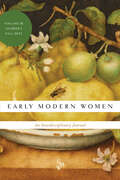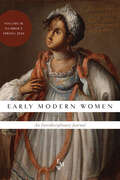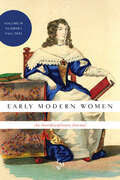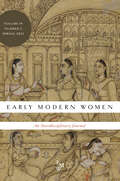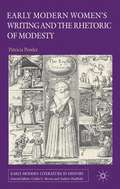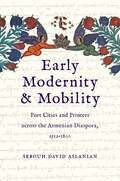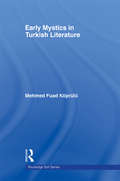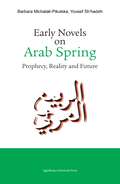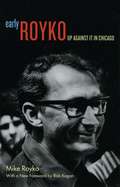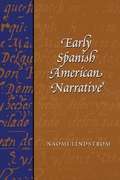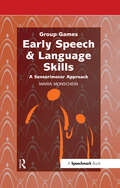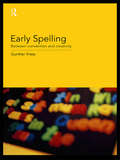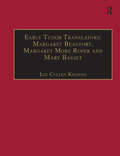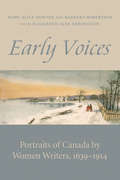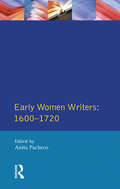- Table View
- List View
Early Modern Women: An Interdisciplinary Journal, volume 18 number 1 (Fall 2023)
by Early Modern Women: An Interdisciplinary JournalThis is volume 18 issue 1 of Early Modern Women: An Interdisciplinary Journal. Early Modern Women: An Interdisciplinary Journal (EMW) is the only journal devoted solely to the interdisciplinary and global study of women and gender spanning the late medieval through early modern periods. Each volume gathers essays on early modern women from every country and region by scholars from a wide range of academic disciplines including art history, cultural studies, music, history, languages and literatures, political science, religion, theatre, history of science, and history of philosophy.
Early Modern Women: An Interdisciplinary Journal, volume 18 number 2 (Spring 2024)
by Early Modern Women: An Interdisciplinary JournalThis is volume 18 issue 2 of Early Modern Women: An Interdisciplinary Journal. Early Modern Women: An Interdisciplinary Journal (EMW) is the only journal devoted solely to the interdisciplinary and global study of women and gender spanning the late medieval through early modern periods. Each volume gathers essays on early modern women from every country and region by scholars from a wide range of academic disciplines including art history, cultural studies, music, history, languages and literatures, political science, religion, theatre, history of science, and history of philosophy.
Early Modern Women: An Interdisciplinary Journal, volume 19 number 1 (Fall 2024)
by Early Modern Women: An Interdisciplinary JournalThis is volume 19 issue 1 of Early Modern Women: An Interdisciplinary Journal. Early Modern Women: An Interdisciplinary Journal (EMW) is the only journal devoted solely to the interdisciplinary and global study of women and gender spanning the late medieval through early modern periods. Each volume gathers essays on early modern women from every country and region by scholars from a wide range of academic disciplines including art history, cultural studies, music, history, languages and literatures, political science, religion, theatre, history of science, and history of philosophy.
Early Modern Women: An Interdisciplinary Journal, volume 19 number 2 (Spring 2025)
by Early Modern Women: An Interdisciplinary JournalThis is volume 19 issue 2 of Early Modern Women: An Interdisciplinary Journal. Early Modern Women: An Interdisciplinary Journal (EMW) is the only journal devoted solely to the interdisciplinary and global study of women and gender spanning the late medieval through early modern periods. Each volume gathers essays on early modern women from every country and region by scholars from a wide range of academic disciplines including art history, cultural studies, music, history, languages and literatures, political science, religion, theatre, history of science, and history of philosophy.
Early Modern Women: An Interdisciplinary Journal, volume 20 number 1 (Fall 2025)
by Early Modern Women: An Interdisciplinary JournalThis is volume 20 issue 1 of Early Modern Women: An Interdisciplinary Journal. Early Modern Women: An Interdisciplinary Journal (EMW) is the only journal devoted solely to the interdisciplinary and global study of women and gender spanning the late medieval through early modern periods. Each volume gathers essays on early modern women from every country and region by scholars from a wide range of academic disciplines including art history, cultural studies, music, history, languages and literatures, political science, religion, theatre, history of science, and history of philosophy.
Early Modern Women’s Writing and the Rhetoric of Modesty
by Patricia PenderAn in-depth study of early modern women's modesty rhetoric from the English Reformation to the Restoration. This book provides new readings of modesty's gendered deployment in the works of Anne Askew, Katharine Parr, Mary Sidney, Aemilia Lanyer and Anne Bradstreet.
Early Modern Écologies: Beyond English Ecocriticism (Environmental Humanities in Pre-modern Cultures)
by Phillip John Usher Pauline GoulEarly Modern Écologies is the first collective volume to offer perspectives on the relationship between contemporary ecological thought and early modern French literature. If Descartes spoke of humans as being ‘masters and possessors of Nature’ in the seventeenth century, the writers taken up in this volume arguably demonstrated a more complex and urgent understanding of the human relationship to our shared planet. Opening up a rich archive of literary and non-literary texts produced by Montaigne and his contemporaries, this volume foregrounds not how ecocriticism renews our understanding of a literary corpus, but rather how that corpus causes us to re-think or to nuance contemporary eco-theory. The sparsely bilingual title (an acute accent on écologies) denotes the primary task at hand: to pluralize (i.e. de-Anglophone-ize) the Environmental Humanities. Featuring established and emerging scholars from Europe and the United States, Early Modern Écologies opens up new dialogues between ecotheorists such as Timothy Morton, Gilles Deleuze, and Bruno Latour and Montaigne, Ronsard, Du Bartas, and Olivier de Serres.
Early Modernity and Mobility: Port Cities and Printers across the Armenian Diaspora, 1512-1800
by Sebouh David AslanianA history of the continent-spanning Armenian print tradition in the early modern period Early Modernity and Mobility explores the disparate yet connected histories of Armenian printing establishments in early modern Europe and Asia. From 1512, when the first Armenian printed codex appeared in Venice, to the end of the early modern period in 1800, Armenian presses operated in nineteen locations across the Armenian diaspora. Linking far-flung locations in Amsterdam, Livorno, Marseille, Saint Petersburg, and Astrakhan to New Julfa, Madras, and Calcutta, Armenian presses published a thousand editions with more than half a million printed volumes in Armenian script. Drawing on extensive archival research, Sebouh David Aslanian explores why certain books were published at certain times, how books were sold across the diaspora, who read them, and how the printed word helped fashion a new collective identity for early modern Armenians. In examining the Armenian print tradition Aslanian tells a larger story about the making of the diaspora itself. Arguing that “confessionalism” and the hardening of boundaries between the Armenian and Roman churches was the “driving engine” of Armenian book history, Aslanian makes a revisionist contribution to the early modern origins of Armenian nationalism.
Early Mystics in Turkish Literature (Routledge Sufi Series)
by Mehmed Fuad KopruluThis book is a translation of one of the most important Turkish scholarly works of the twentieth century. It was the masterpiece of M.F. Koprulu, one of Turkey’s leading, and most prolific, intellectuals and scholars. Using a wide variety of Arabic, and especially Turkish and Persian sources, this book sheds light on the early development of Turkish literature and attempts to show the continuity in this development between the Turks and that of Anatolia. Early Mystics in Turkish Literature addresses this topic within the context of other subjects, including Sufism, Islam and the genesis of Turkish culture in the Muslim world. This is a major contribution to the study of Turkish literature and is essential reading for scholars of Turkish literature, Islam, Sufism and Turkish history.
Early Novels on Arab Spring: Prophecy, Reality and Future
by Barbara Michalak-Pikulska Yousef Sh’hadehThe authors of this book present a study of the first Arab novels that dealt with the Arab Spring in the period 2011-2013. They show the rapid reaction of Arab novelists to what happened in their countries at that time. Dozens of narrative works have been published that heralded the advent of change and the victory of popular movements, glorifying the rebellious uprisings against tyrannical regimes. Few predicted the outbreak of the revolution before the occurrence of these major events. They also presented a comprehensive picture of what was going on in Arab societies during that difficult period. The revolutions left many victims, and for this reason pessimism and despair permeate some texts, but others paint a bright picture of the future of the Arab Spring, which may lead to the realization of the dream of freedom and democracy.The young generation, which by means of the internet and social media contributed to the outbreak of the revolution, is ready to fight for its own ideals and freedom. Its representatives are fascinated by the power of revolution and the rapid course of events. They boldly face death in the hope that the sacrifice of their lives will bring about a better future for their children. It was young people, not politicians and party leaders, who planned the revolution demanding freedom, dignity, equality and justice.
Early Postmodernism: Foundational Essays
by Paul A. BovéIn the decade that followed 1972, the journal boundary 2 consistently published many of the most distinguished and most influential statements of an emerging literary postmodernism. Recognizing postmodernism as a dominant force in culture, particularly in the literary and narrative imagination, the journal appeared when literary critical study in the United States was in a period of theory-induced ferment. The fundamental relations between postmodernism and poststructuralism were being initially examined and the effort to formulate a critical sense of the postmodern was underway. In this volume, Paul A. Bové, the current editor of boundary 2, has gathered many of those foundational essays and, as such, has assembled a basic text in the history of postmodernism.Essays by noted cultural and literary theorists join with Bové's contemporary preface to represent the important and unique moment in recent intellectual history when postmodernism was no longer seen primarily as an architectural term, had not yet come to describe the wide range of culture it does now, but was finding power and place in the literary realm. These essays show that the history of postmodernism and its attendant critical theories are both more complex and more deeply bound with literary criticism than often is acknowledged today. Early Postmodernism demonstrates not only the significance of these literary studies, but also the role played by literary critical postmodernism in making possible newer forms of critical and cultural studies.Contributors. Barry Alpert, Charles Altieri, David Antin, Harold Bloom, Paul A. Bové, Hélène Cixous, Gerald Gillespie, Ihab Hassan, Joseph N. Riddel, William, V. Spanos, Catharine R. Stimpson, Cornel West
Early Public Libraries and Colonial Citizenship in the British Southern Hemisphere (New Directions in Book History)
by Porscha Fermanis Sarah Comyn Lara Atkin Nathan GarveyThis open access Pivot book is a comparative study of six early colonial public libraries in nineteenth-century Australia, South Africa, and Southeast Asia. Drawing on networked conceptualisations of empire, transnational frameworks, and ‘new imperial history’ paradigms that privilege imbricated colonial and metropolitan ‘intercultures’, it looks at the neglected role of public libraries in shaping a programme of Anglophone civic education, scientific knowledge creation, and modernisation in the British southern hemisphere. The book’s six chapters analyse institutional models and precedents, reading publics and types, book holdings and catalogues, and regional scientific networks in order to demonstrate the significance of these libraries for the construction of colonial identity, citizenship, and national self-government as well as charting their influence in shaping perceptions of social class, gender, and race. Using primary source material from the recently completed ‘Book Catalogues of the Colonial Southern Hemisphere’ digital archive, the book argues that public libraries played a formative role in colonial public discourse, contributing to broader debates on imperial citizenship and nation-statehood across different geographic, cultural, and linguistic borders.
Early Puerto Rican Cinema and Nation Building: National Sentiments, Transnational Realities, 1897-1940 (Bucknell Studies in Latin American Literature and Theory)
by Naida García-CrespoEarly Puerto Rican Cinema and Nation Building focuses on the processes of Puerto Rican national identity formation as seen through the historical development of cinema on the island between 1897 and 1940. Anchoring her work in archival sources in film technology, economy, and education, Naida García-Crespo argues that Puerto Rico’s position as a stateless nation allows for a fresh understanding of national cinema based on perceptions of productive cultural contributions rather than on citizenship or state structures. This book aims to contribute to recently expanding discussions of cultural networks by analyzing how Puerto Rican cinema navigates the problems arising from the connection and/or disjunction between nation and state. The author argues that Puerto Rico’s position as a stateless nation puts pressure on traditional conceptions of national cinema, which tend to rely on assumptions of state support or a bounded nation-state. She also contends that the cultural and business practices associated with early cinema reveal that transnationalism is an integral part of national identities and their development. García-Crespo shows throughout this book that the development and circulation of cinema in Puerto Rico illustrate how the “national” is built from transnational connections. Published by Bucknell University Press. Distributed worldwide by Rutgers University Press.
Early Reading Comprehension in Varied Subject Matter: Book A
by Jane ErvinThis series has a consistent format that allows students in the same class to use different levels. It builds reading comprehension skills, contextual vocabulary skills, and provides cross-curricular reading practice via content-area topics.
Early Reading Comprehension in Varied Subject Matter: Book B
by Jane ErvinThis series has a consistent format that allows students in the same class to use different levels. It builds reading comprehension skills, contextual vocabulary skills, and provides cross-curricular reading practice via content-area topics.
Early Reading Comprehension in Varied Subject Matter: Book C
by Jane ErvinThis popular series offers nonfiction reading passages with comprehension questions on a variety of subjects for students in second grade through junior high school and beyond.
Early Reading Instruction: What Science Really Tells Us About How To Teach Reading
by Diane McguinnessEarly Reading Instruction is a comprehensive analysis of the research evidence from early writing systems to computer models of reading. In this book, Diane McGuinness provides an innovative solution to the "reading war"--the century-old debate over the efficacy of phonics (sound-based) versus whole-word (meaning- based) methods. She has developed a prototype--a set of elements that are critical to the success of a reading method. McGuinness shows that all writing systems, without exception, are based on a sound unit in the language. This fact, and other findings by paleographers, provides a platform for the prototype. Other elements of the prototype are based on modern research. For example, observational studies in the classroom show that time spent on three activities strongly predicts reading success: learning phoneme/symbol correspondences, practice at blending and segmenting phonemes in words, and copying/writing words, phrases, and sentences. Most so-called literacy activities have no effect, and some, like sight word memorization, have a strongly negative effect. The National Reading Panel (2000) summarized the research on reading methods after screening out thousands of studies that failed to meet minimum scientific standards. In an in-depth analysis of this evidence, McGuinness shows that the most successful methods (children reading a year or more above age norms) include all the elements in the prototype. Finally, she argues, because phonics-type methods are consistently shown to be superior to whole-word methods in studies dating back to the 1960s, it makes no sense to continue this line of research. The most urgent question for future research is how to get the most effective phonics programs into the classroom.
Early Royko: Up Against It in Chicago
by Mike RoykoCombining the incisive pen of a newspaperman and the compassionate soul of a poet, Mike Royko became a Chicago institution—in Jimmy Breslin’s words, "the best journalist of his time." Early Royko: Up Against It in Chicago will restore to print the legendary columnist’s earliest writings, which chronicle 1960s Chicago with the moral vision, ironic sense, and razor-sharp voice that would remain Royko’s trademark. This collection of early columns from the Chicago Daily News ranges from witty social commentary to politically astute satire. Some of the pieces are falling-down funny and others are tenderly nostalgic, but all display Royko’s unrivaled skill at using humor to tell truth to power. From machine politicians and gangsters to professional athletes, from well-heeled Chicagoans to down-and-out hoodlums, no one escapes Royko’s penetrating gaze—and resounding judgment. Early Royko features a memorable collection of characters, including such well-known figures as Hugh Hefner, Mayor Richard J. Daley, and Dr. Martin Luther King. But these boldfaced names are juxtaposed with Royko’s beloved lesser knowns from the streets of Chicago: Mrs. Peak, Sylvester "Two-Gun Pete" Washington, and Fats Boylermaker, who gained fame for leaning against a corner light pole from 2 a.m. Saturday until noon Sunday, when his neighborhood tavern reopened for business. Accompanied by a foreword from Rick Kogan, this new edition will delight Royko’s most ardent fans and capture the hearts of a new generation of readers. As Kogan writes, Early Royko "will remind us how a remarkable relationship began—Chicago and Royko, Royko and Chicago—and how it endures."
Early Spanish American Narrative
by Naomi LindstromThe world discovered Latin American literature in the twentieth century, but the roots of this rich literary tradition reach back beyond Columbus's discovery of the New World. The great pre-Hispanic civilizations composed narrative accounts of the acts of gods and kings. Conquistadors and friars, as well as their Amerindian subjects, recorded the clash of cultures that followed the Spanish conquest. Three hundred years of colonization and the struggle for independence gave rise to a diverse body of literature--including the novel, which flourished in the second half of the nineteenth century. To give everyone interested in contemporary Spanish American fiction a broad understanding of its literary antecedents, this book offers an authoritative survey of four centuries of Spanish American narrative. Naomi Lindstrom begins with Amerindian narratives and moves forward chronologically through the conquest and colonial eras, the wars for independence, and the nineteenth century. She focuses on the trends and movements that characterized the development of prose narrative in Spanish America, with incisive discussions of representative works from each era. Her inclusion of women and Amerindian authors who have been downplayed in other survey works, as well as her overview of recent critical assessments of early Spanish American narratives, makes this book especially useful for college students and professors.
Early Speech & Language Skills: A Sensorimotor Approach (Group Games Ser.)
by Lilo Seelos Maria MonscheinFull of practical ideas that can be easily implemented with minimal preparation, this book contains a wealth of games and activities for developing language with young children. Following a multi-sensory approach, the games focus on having fun and working on speech language difficulties without having to concentrate directly on speaking. The games are organised around the school year and are themed according to which sense they specifically aim to develop. Most games can be carried out with little preparation, are easily adaptable and can be differentiated according to different children's abilities. Includes: Sense of touch games; Games for proprioception; Balancing games; Listening games; Games for developing hand-eye coordination and finger-motor skills; Games for promoting oral motor skills; Games for working on individual problematic speech sounds.
Early Spelling: From Convention to Creativity
by Gunther KressIn his latest book, Gunther Kress explores how children learn to spell in the context of current concerns about early literacy. Using numerous examples of children's writing and drawing, Kress looks at children as 'makers of meaning' and explores their earliest ventures into writing.Kress covers problems such as dyslexia within today's educational system. Technological aids on spelling and writing such as spell-checkers and the effects of the increasing visualization of communication (computer, TV, film) are also discussed.
Early Tudor Translators: Printed Writings 1500–1640: Series I, Part Two, Volume 4 (The Early Modern Englishwoman: A Facsimile Library of Essential Works & Printed Writings, 1500-1640: Series I, Part Two)
by Lee Cullen KhannaThis volume presents the texts of three Englishwomen remarkable both for writing and publishing their work during the first half of the sixteenth century. They also proved themselves nimble survivors of political and religious turmoil, Beaufort suffering for her Lancastrian connections and Roper and Basset for their Catholic allegiance. Significantly, these women turned to translation and to religious texts for their writing and publishing. The choice of devotional treatises authored by men not only mitigated the threat of the female pen, but more important to these writers, enabled them to perform spiritual and material work. Translation was considered to be the fruit of faith, contributing to the writer's own salvation and that of others, notably other women. Margaret Beaufort - Countess of Richmond and Derby, and mother of Henry VII. Lady Margaret's translation of the fourth book of Thomas à Kempis' De imitatione Christi was the first in English. Published in 1504 with Books 1-3, translated by William Atkinson. We reprint Pynson's 1517 edition notable for the clarity of its texts and woodcuts. Her translation from a French version of the anonymous text Speculum aureum animae peccatricis was published by Pynson in about 1506. It was reprinted three times after her death, twice in 1522 and once in 1526. We reprint the 1526 edition held by the British Library. Margaret More Roper was the eldest child of Sir Thomas More and was said to have been an outstanding scholar and writer. Her only published work is the translation reproduced here - Erasmus: A devout treatise upon the Pater noster, published c.1526 by T. Berthelet Mary Roper Clarke Basset was the daughter of Margaret Roper. She was a lady-in-waiting to Queen Mary and an expert in Latin and Greek. Reprinted here is a copy of her translation of her grandfather's final Tower work Of the sorrowe ... of Christ before hys taking from the 1557 edition of The English Workes of Sir Thomas More.
Early Vision
by Samuel Taylor Coleridge Richard HolmesRichard Holmes edits a collection of poems by Samuel Taylor Coleridge, a pioneer of English Romanticism.
Early Voices: Portraits of Canada by Women Writers, 1639-1914
by Mary Alice Downie Barbara Robertson Elizabeth Jane ErringtonThis selection of writings by 29 women, known and unknown, professional and amateur, presents a unique portrait of Canada through time and space, from the 17th to the early 20th century, from the Maritimes to British Columbia and the Far North. There is a range of voices from high-born wives of governors general, to an Icelandic immigrant and a fisherman’s wife in Labrador. A Loyalist wife and mother describes the first hard weather in New Brunswick, a seasick nun tells of a dangerous voyage out from France, a famous children’s writer writes home about the fun of canoeing, and a German general’s wife describes habitant customs. All demonstrate how women’s experiences not only shared, but helped shape this new country.
Early Women Writers: 1600 - 1720 (Longman Critical Readers)
by Anita PachecoThe last twenty years have witnessed the rediscovery of a large number of women writers of the early modern period. This process of recovery has had a major impact on early modern studies for, by beginning to restore women to the history of the period, it provides new insight into the formative years of the modern era.This collection amply demonstrates the diversity as well as the literary and historical significance of early women's writing. It brings together studies by an impressive range of critics, including Elaine Hobby, Catherine Gallagher, Jane Spencer and Laura Brown, and examines the major works of five of the most important women writers of the seventeenth and early eighteenth centuries: Mary Wroth, Katherine Philips, Margaret Cavendish, Aphra Behn and Anne Finch. The range of authors it covers, and the challenging critical work it presents, make Early Women Writers: 1600-1720 essential reading for students of feminist theory, Women's Studies and Cultural Studies, as well as for all those interested in the history and literature of the early modern period.
